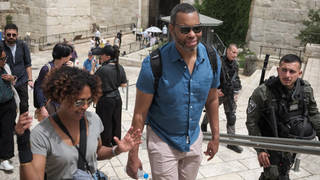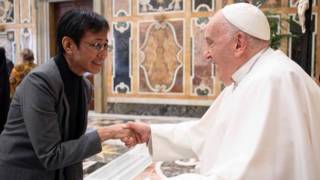
Guests
- Sherif MansourMiddle East and North Africa program coordinator for the Committee to Protect Journalists.
The Committee to Protect Journalists reports that at least 50 journalists and media workers have been killed in Israel’s ongoing assault on Gaza. Forty-five of the slain journalists have been Palestinian. Others have been arrested or injured. According to CPJ, this has been the deadliest period for journalists covering conflict since the media group began tracking deaths over 30 years ago. Meanwhile, journalists in Israel and the West Bank have been confronted with cyberattacks, physical assault and other forms of censorship for allegedly “harming national morale and harming national security” while reporting on Israel. It’s a “news blackout,” says CPJ’s program coordinator for the Middle East and North Africa Sherif Mansour, under which the Israeli government is blocking “essential media coverage” and withholding “lifesaving information” from Gaza in order to win its Western propaganda war.
Transcript
AMY GOODMAN: It’s been another devastating 24 hours in Gaza and southern Lebanon for journalists covering the 46-day Israeli bombardment. The Beirut-based TV channel Al Mayadeen has just announced two of its journalists were killed today in an Israeli airstrike in southern Lebanon. The network says correspondent Farah Omar and camera operator Rabih Al-Me’mari were deliberately targeted by an Israeli warplane after reporting on Israel’s latest bombardment of south Lebanon.
Meanwhile, in northern Gaza, Ayat Khaddura, a 27-year-old digital content and podcast presenter, has been reportedly killed along with her family in an Israeli airstrike. This is Ayat, one of her last video reports.
AYAT KHADDURA: [translated] This may be the last video for me. Today, the occupation dropped phosphorus bombs on the Beit Lahia project area and scary sound bombs and threw evacuation notices in the area. And, of course, almost the entire area has evacuated. Everyone started running madly in the streets. No one knows neither where they’re going to or coming from. We’re separated, of course. I and a few others remain at home, while the rest have evacuated, and we don’t know where they went. The situation is very scary. The situation is very terrifying. What is happening is very difficult. May God have mercy on us.
AMY GOODMAN: On Sunday, the head of the Gaza Press House was also killed by the Israeli military. Belal Jadallah was heading to southern Gaza when he was killed by an Israeli tank shell in the Zeitoun neighborhood of Gaza City. Belal was known as the “Godfather” of Palestinian journalism. He helped train generations of reporters and welcomed foreign correspondents and sponsored them when covering the Gaza Strip.
The Committee to Protect Journalists Monday announced a grim milestone had been reached with at least 50 journalists and media workers killed since October 7th. Forty-five of the journalists have been Palestinian. There have been three Israeli journalists killed, and there have been at least three Lebanese journalists killed. CPJ reports 11 journalists have been injured, three are reported missing, and 18 have been arrested. According to CPJ, the past month and a half has been the deadliest period of journalists covering the conflict since the media group began tracking these deaths over 30 years ago.
We go now to Philadelphia, where we’re joined by Sherif Mansour, the Middle East and North Africa program coordinator for the Committee to Protect Journalists.
Sherif, welcome back to Democracy Now!, under horrific circumstances. The U.N. secretary-general says that the number of civilian deaths is “unparalleled and unprecedented.” Of course, journalists are civilians. As I woke up this morning, I got one text after another, first the young woman and her cameraman in southern Lebanon killed about an hour after she posted a video report. She’s standing in a field in southern Lebanon, and she’s talking about the Israeli military killing civilians. She and her cameraman are then hit and killed. And then, as I’m learning their names, another text comes in. This young reporter in northern Gaza is killed, even as she says in her report, “I fear I will die.” Can you talk about this latest news and then a man you have come to know, who worked with you on a CPJ report, the head of the Gaza journalists’ association, also killed in an airstrike?
SHERIF MANSOUR: Thank you, Amy, for having me.
I remember being on your show a little bit more of a month ago and saying, for journalists in the region, this is a deadly time. And it was the deadliest week back then. It became the deadliest month and now the deadliest six weeks on our record. I was not exaggerating. I was not speculating.
The killing of Belal Jadallah, who helped us document this deadly pattern of journalists being killed by Israeli fire over 21 years — just in May, we made a profile of 20 journalists. The majority, 18, were Palestinians. And he, Jadallah, his center have helped identify them, their families, get us their pictures. And on Sunday, he became a victim of this same deadly pattern when he was killed in his car. Jadallah has also provided crucial safety equipment for journalists in order to do their job safely. And he opened the Press House for journalists to use the electricity and internet when there was no other place.
This deadly pattern has existed before. It’s getting more deadly per day. We are investigating the three more killing today, adding to 50 as of yesterday. We’ve never seen anything like this. It’s unprecedented. And for journalists in Gaza specifically, the exponential risk is possibly the most dangerous we have seen. Journalists were killed in the very early stages at the two entry and exit points from Gaza — in the south, the Rafah crossing; in the north, the Erez crossing. And since then, they were killed everywhere in between. They were killed in the south in Rafah City, in Khan Younis, where they were told it’s going to be safe. They were killed in the middle in the Gaza Strip. And they were killed in the north in Gaza City. They have no safe haven. They have no exit.
JUAN GONZÁLEZ: Sherif, could you talk, as well, about the arrests of journalists in Gaza and the Occupied Territories? And also, your organization has criticized, as well, Israel for its censorship within Israel of the press in Israel. Could you talk about that, as well?
SHERIF MANSOUR: Well, we have documented separately from the casualties list, which includes journalists going missing, injured, the escalation of arrests. As of yesterday, 18 Palestinian journalists from the West Bank were arrested. Many of them were put in administrative detention, in military prosecutions. In addition, dozens of cases of censorship, direct censorship, cyberattacks, physical assaults, obstruction from coverage within the West Bank and within Israel.
In Israel, an emergency legislation has now given the government for the first time the unprecedented power of shutting down international media organization, including acting on Al Mayadeen — which two journalists were killed today in Lebanon — banning them in Israel, and allowing the government also to jail even Israeli journalists for up to a year under suspicious and these accusations of harming national morale and harming national security.
JUAN GONZÁLEZ: Also, here in the United States, we are getting much coverage on the commercial media of the war, of the Israeli war in Gaza, but it’s all of U.S. journalists that are basically based in Israel, and there are no U.S. journalists that I’ve seen that are actually in Gaza. And those who do go in only go in with the Israeli army and under the condition that Israel must review all of their videotape beforehand and approve it before it can go out. I’m wondering your sense of how the American people — what kind of story they’re getting as a result of these conditions?
SHERIF MANSOUR: Well, these conditions put local Palestinian photojournalists and freelancers at the most risk. They are the ones on the frontlines. We have not — we have seen a dwindling number of international media and international journalists within Gaza over the years because of the risks involved. And right now the Palestinian journalists are bearing the brunt of this risk and this heavy toll.
Of course, these casualties, the censorship is also coupled with communication blackouts for, to date, since the start of the war, that makes this more often news blackout, not just communication blackout. And, of course, that denies journalists a voice. It also denies people in the region and worldwide of essential media coverage, lifesaving information for 2 million Palestinians who are struggling to find food, clean water and shelter right now, but millions and hundreds of millions all over the world who are following this heartbreaking conflict and try to understand it, including in the U.S.
AMY GOODMAN: So, as Juan said, Sherif, you have — the Israeli military says they cannot guarantee the lives of journalists that go into Gaza. In early November — I’m just thinking back to a few weeks ago — the Palestine News Agency reported that their journalist Mohammad Abu Hattab was killed in an Israeli strike on his home in southern Gaza Strip along with 11 members of his family, including his wife, son and brother. His colleague, journalist Salman Al-Bashir, burst into tears during a live broadcast upon learning of Abu Hattab’s killing. As he spoke, Al-Bashir tore off his helmet and protective vest, labeled “press,” and threw them to the ground. And then there was a split screen, as he ripped off his gear, saying, “Why do we bother wearing this if we’re going to be killed anyway?” They showed the anchor back in the Palestine news studio as she wept as Al-Bashir tore off his helmet and protective vest. Your response to this situation and this whole issue of embedded journalism is the only way the U.S. media can get those reports inside Gaza, where their news reports are reviewed, and the Gazan journalists on the ground being killed one after another, dozens of Palestinian journalists killed?
SHERIF MANSOUR: Well, the Israeli army cannot escape or evade their responsibility under international law not to use unwarranted lethal force against journalists and against media facilities. It would constitute a possible war crime to do so. We have raised directly with Israeli officials the need for them to reform the rules of engagement, to respect press insignia and to ensure there are safeguards, checks when civilians and journalists are around. We have called for Israeli allies, including the U.S. government, European allies, to raise directly these issues, and publicly, with their Israeli counterparts. And we have called for the U.N. Security Council to include safety of journalists on the agenda in any diplomatic discussion.
Of course, the Israeli government are obliged under international law to protect journalists as civilians, but it’s also journalists’ vital role in time of war providing accurate, timely, independent information that gives them these protections under international law. And we want to make sure that the Israeli army, as well, do not continue to push false narratives and smear campaigns to try and justify the killing of those journalists.
AMY GOODMAN: Sherif Mansour, we want to thank you for being with us, Middle East and North Africa program coordinator for the Committee to Protect Journalists, speaking to us from Philadelphia.
Coming up, the acclaimed Palestinian poet Mosab Abu Toha has been detained at an Israeli checkpoint in Gaza, his whereabouts now unknown. Back in 20 seconds.













Media Options